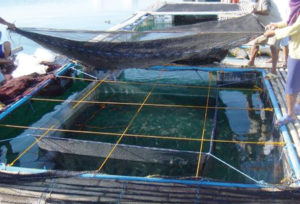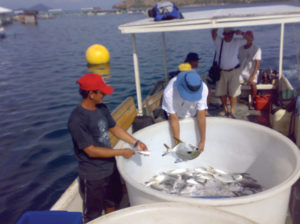Low-volume, high-density systems boost productivity, profitability

The American Soybean Association – International Marketing (ASA-IM) program Soy-In-Aquaculture project in the Philippines has introduced low-volume, high-density (LVHD) cage culture production methodology for use with high-value marine species. This technology was developed by ASA-IM in China with the aims of maximizing farmers’ profits, improving productivity, reducing feed-conversion ratios and limiting environmental degradation.
The system maximizes production through the use of good cage site selection, proper cage positioning, maximum cage volumes and densities, high-quality extruded floating feeds and proper feed management to reduce or prevent disease.
Cage design, orientation
The water quality at LVHD sites can be controlled using a target biomass and specific cage designs and orientation. In marine cages, a final harvest biomass of 50-75 kg/m3 is targeted based on effective water volume enclosed by the cage and surrounding conditions.
The cage design and net mesh size should allow good water exchange inside the cages to maintain dissolved oxygen at a safe level throughout the period of the culture. Cages should be oriented perpendicular to the water current and positioned with at least one cage width between cages in each row. Cage rows should be positioned far enough apart to permit good water exchange.
Feed
One of the most important aspects of a formulated feed-based system is strict feed management using high-quality feeds. Feed is the most expensive part of any production scheme, accounting for 70 to 80 percent of the production cost, and therefore should be used effectively and efficiently.
Soy-In-Aquaculture research has shown that the highest production efficiency is obtained using a floating, extruded feed with a feed enclosure to keep feeds within the cage during feeding. The ASA-IM 90 percent-satiation feeding technique was also developed to help limit wastage of feed.
Introduction of technology

In the Philippines, fish farmers usually used high-volume, low-density cages of 180-1,000 m3 size and fed pelletized sinking feeds ad libitum to produce 10-15 kg/m3 at harvest. They also typically did not change mesh sizes during culture and paid little attention to water exchange in the cage. This led them to believe that a harvest biomass of less than 20 kg/m3 was the maximum they could achieve.
Initially, Philippine fish farmers were very conservative and hesitant about adopting the LVHD technology, and particularly the new feeding techniques using extruded feeds with high-value marine fish species. This conservative attitude was highlighted with two projects in 2007 using pompano, Trachinotus blochii, in cage-feeding demonstrations conducted at Alsons Aquaculture Corp. in Davao del Sur, Philippines, and Reprotech Inc. in Negros Oriental, Philippines.
These projects used three 8- or 27-m3 floating cages, respectively, that targeted a final biomass of 50 kg/m3 of fish harvested at the conclusion of the projects using a 43 percent-protein, 12 percent-fat domestically produced, extruded floating aquafeed.
Some of the difficulties seen in adopting the cage production technology were the incorrect application of the 90 percent-satiation feeding technique, improper use of feed enclosures in the cages and particular lack of attention paid to cage mesh size and the water exchange capability of the system, which are critical for good results in a high-density system.
Technical support
The ASA-IM program helped show farmers other ways to culture high-value marine fish using smaller cages and higher target densities. It provided close technical support to demonstrate the LVHD cage culture system and continually trained feed managers in the proper way of using the 90 percent-satiation feeding technique throughout the production cycle.
Advice on the proper design and placement of feed enclosures helped prevent floating feed from exiting the cages. This system also taught the farmers the importance of monitoring the relationship of the size of the net mesh to the size of the fish for good water exchange inside the cage.
Perspectives
Despite some challenges encountered in implementing the new technology, the farmers were able to realize the benefits of adopting the new technology compared to their traditional commercial cage culture methods. They had cost savings on both feed consumption and labor using the 90 percent-satiation feeding method without sacrificing fish growth. Using extruded floating feeds helped the farmers better manage their feed use as well as limit environment degradation.
(Editor’s Note: This article was originally published in the January/February 2009 print edition of the Global Aquaculture Advocate.)
Now that you've finished reading the article ...
… we hope you’ll consider supporting our mission to document the evolution of the global aquaculture industry and share our vast network of contributors’ expansive knowledge every week.
By becoming a Global Seafood Alliance member, you’re ensuring that all of the pre-competitive work we do through member benefits, resources and events can continue. Individual membership costs just $50 a year. GSA individual and corporate members receive complimentary access to a series of GOAL virtual events beginning in April. Join now.
Not a GSA member? Join us.
Authors
-
Levy Loreto L. Manalac
American Soybean Association – International Marketing
37 Bonuan Sabangan, Bonuan Gueset
Dagupan City, Pangasinan
2400 Philippines[109,111,99,46,111,111,104,97,121,64,48,48,48,50,55,49,55,121,118,101,108]
-
Dr. Michael C. Cremer
American Soybean Association – International Marketing
St. Louis, Missouri, USA -
Lukas Manomaitis
American Soybean Association – International Marketing
Southeast Asia Representative Office
Singapore
Tagged With
Related Posts

Health & Welfare
A holistic management approach to EMS
Early Mortality Syndrome has devastated farmed shrimp in Asia and Latin America. With better understanding of the pathogen and the development and improvement of novel strategies, shrimp farmers are now able to better manage the disease.

Responsibility
A look at integrated multi-trophic aquaculture
In integrated multi-trophic aquaculture, farmers combine the cultivation of fed species such as finfish or shrimp with extractive seaweeds, aquatic plants and shellfish and other invertebrates that recapture organic and inorganic particulate nutrients for their growth.

Aquafeeds
A look at protease enzymes in crustacean nutrition
Food digestion involves digestive enzymes to break down polymeric macromolecules and facilitate nutrient absorption. Enzyme supplementation in aquafeeds is a major alternative to improve feed quality and nutrient digestibility, gut health, compensate digestive enzymes when needed, and may also improve immune responses.

Responsibility
In-pond raceway system demonstrates economic benefits for catfish production
Auburn University researched how to improve economic efficiency and profitability of catfish production with in-pond raceway systems. IPRS systems help achieve high levels of feed performance and fish survival, and lower production costs.


